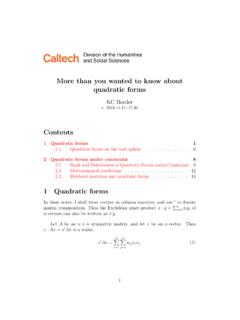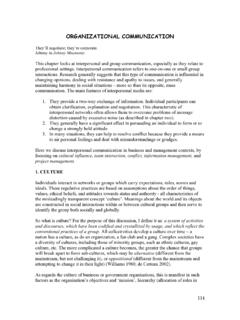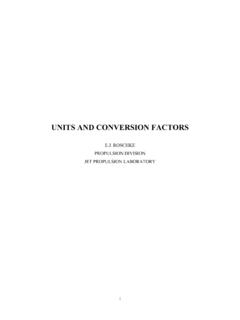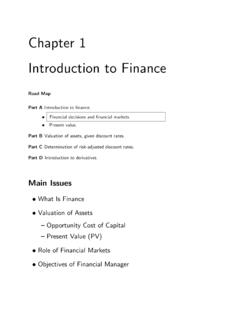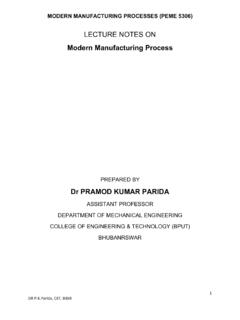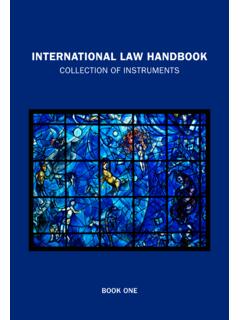Transcription of Chapter 5 Capital Budgeting - its.caltech.edu
1 Chapter 5 Capital BudgetingRoad MapPart AIntroduction to BValuation of assets, given discount rates. Fixed-Income securities. Common stocks. Real assets ( Capital Budgeting ).Part CDetermination of risk-adjusted discount DIntroduction to Issues NPV Rule Cash Flow Calculations Alternatives to NPV RuleChapter 5 Capital Budgeting5-11 NPV RuleA firm s business involves Capital investments ( Capital Budgeting ), , the acquisition of real assets. The objective is to increasethe firm s current market value. Decision reduces to valuing realassets, , their cash the cash flow of an investment (a project) be{CF0,CF1, ,CFt}.
2 Its current market value isNPV=CF0+CF11+r1+ +CFt(1+rt) is the increase in firm s market value by the Criteria:1. For a single project, take it if and only if its NPV is For manyindependentprojects, take all those with Formutually exclusiveprojects, take the one with positive andhighest 2006c J. lecture Notes5-2 Capital BudgetingChapter 5In order to compute the NPV of a project, we need to analyze1. Cash flows2. Discount rates3. Strategic focus on cash flow here and return to discount rate (Part C)and strategic options (Part D) lecture Notesc J. WangFall 2006 Chapter 5 Capital Budgeting5-32 Cash Flow CalculationsMain Points:1.
3 Use cash flows, not accounting Use after-tax cash Use cash flows attributable to the project (compare firm valuewith and without the project): Use incremental cash flows. Forget sunk costs: bygones are bygones. Include investment in working Capital as Capital expendi-ture. Include opportunity costs of using existing 2006c J. lecture Notes5-4 Capital BudgetingChapter 5In what follows, all cash flows are attributable to the [Project Cash Inflows] [Project Cash Outflows]=[Operating Revenues] [Operating Expenses without depreciation] [ Capital Expenditures] [Taxes].
4 Defining operating profit byOperating Profit=Operating Revenues Operating Expenses w/o DepreciationLet denote the effective tax rate. The income taxes are[Taxes]=( )[Operating Profit] ( ) [Depreciation].Accounting depreciation affects cash flows because it reduces thecompany s tax (1 )[Operating Profits] [ Capital Expenditures]+( )[Depreciation]. lecture Notesc J. WangFall 2006 Chapter 5 Capital Use Cash Flows, Not Accounting Earnings vs. Cash machine purchased for $1,000,000 with a life of 10 yearsgenerates annual revenues of $300,000 and operating expenses of$100,000.
5 Assume that machine will be depreciated over 10 yearsusing straight-line depreciation. The corporate tax rate is 40%.DateAccounting EarningsAccounting EarningsCash Flow After-taxBefore TaxAfter Tax000- 1,000,0001300,000 - 100,000 - 100,000 =( )(100,000) =( ) (300,000-100,00) +100,00060,00040,000 = 160,0002100,00060,000160,0003100,00060,0 00160,0004100,00060,000160,0005100,00060 ,000160,0006100,00060,000160,0007100,000 60,000160,0008100,00060,000160,0009100,0 0060,000160,00010100,00060,000160,000 The accounting earnings donotaccurately reflect the actualtiming of cash 2006c J.
6 lecture Notes5-6 Capital BudgetingChapter Use After-tax Cash the following project (the cash flow is inthousands of dollars and tax rate is 50%):Year012345 Invest500 Operating CF0100300300300 Depreciation100100100100100 Income-1000200200200 Tax-500100100100 After-tax CF-50050100200200200PV at 10%-500 + lecture Notesc J. WangFall 2006 Chapter 5 Capital Investment In WC Is A Capital ExpenditureTypically, there are timing differences between the accountingmeasure of earnings (Sales - Cost of Goods Sold) and cash Capital (WC)=Inventory+A/R in Working Capital Inventory: Cost of goods sold includes only the cost of itemssold.
7 When inventory is rising, the cost of goods sold under-states cash outflows. When inventory is falling, cost of goodssold overstates cash outflows. Accounts Receivable (A/R): Accounting sales may reflect salesthat have not been paid for. Accounting sales understate cashinflows if the company is receiving payment for sales in pastperiods. Accounts Payable (A/P) conceptually the reverse of 2006c J. lecture Notes5-8 Capital BudgetingChapter run a chain of stores that sell sweaters. Thisquarter, you buy 1,000,000 sweaters at a price of $ the next two quarters, you sell 500,000 sweaters each quarterfor $ each.
8 The corporate tax rate is 40%. In million dollars,your cash flows areDateAfter Tax ProfitInventoryCash Flow00(1)(30) = 30-301( )(60-30)( ) = 9( )(30) = 15( )(60) - ( )(60-30)( ) = 242( )(60-30)( ) = 90( )(60) - ( )(60-30)( ) = 24 Note:Cash flow=Profit (after tax) Change in lecture Notesc J. WangFall 2006 Chapter 5 Capital Use Market ValuationExample. Reopen King Solomon s mine: Initial investment $ M Capacity million oz for a life of 1year Production cost $200 per oz Current gold priceP0= $400per oz Forecasted gold price growth 5% by bearish manager Discount rate 10%.
9 NPV using the forecast:NPV= +( )(420) $ , gold pays no dividend. Thus,P0=PV(P1)andNPV= Investment+PV(Payoff))= +PV( P1)= + 40 = +$ today s gold 2006c J. lecture Notes5-10 Capital BudgetingChapter 5 Example(Gromb). MSW Inc. is considering the introduction ofa new product: Turbo-Widgets (TW). TW were developed at an R&D cost of $1M over past 3 years New machine to produce TW would cost $2M New machine lasts for 15 years, with salvage value of $50,000 New machine can be depreciated linearly to $0 over 10 years TW need to be painted; this can be done using excess capacityof the painting machine, which currently runs at a cost of$30,000 (regardless of how much it is used) Operating cost: $40,000 per year Sales: $400,000, but cannibalization would lead existing salesof regular widgets to decrease by $20,000 Working Capital (WC): $250,000 needed over the life of theproject Tax rate: 34% Opportunity cost of Capital : 10%.
10 Question: What is the project s NPV ( , should MSW go aheadwith the production of TW)? lecture Notesc J. WangFall 2006 Chapter 5 Capital Budgeting5-111. Initial investment includes Capital expenditure and WC2. R&D expense is a sunk cost3. Depreciation is $2M/10 = $ for first 10 years4. Project should not be charged for painting-machine time5. Project should be charged for cannibalization of regular widgetsales6. Salvage value is fully taxable since the book value at the endof year 10 is $0 (the machine cost has been fully depreciated).The cash flows (in thousand dollars) areYearCash Flow0- (2000+250) = -22501-10(400-40-20)( ) + (200)( ) = (400-40-20)( ) = + (50)( ) + 250 = $57, 2006c J.
